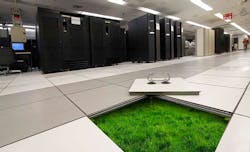Seeking the Next Frontier in Data Center Energy Efficiency
Today we continue our Data Center Executive Roundtable, a quarterly feature showcasing the insights of thought leaders on the state of the data center industry, and where it is headed. In today’s discussion, our panel of experienced data center executives – Thomas Doherty of Aligned Data Centers, Matt Miszewski of Digital Realty, Steve Hassell of Emerson Network Power, Jeff Klaus of Intel DCM, Joel Stone of RagingWire Data Centers and Jason Mendenhall of Switch – examines the data center industry’s track record on energy efficiency, where we’re at and where we’re going. The conversation is moderated by Rich Miller, the founder and editor of Data Center Frontier.
Data Center Frontier: In recent years, the data center industry has made solid progress on energy efficiency. What are the most promising opportunities and strategies for continued improvement?
JOEL STONE, RagingWire
Joel Stone: The next wave of energy efficiency in data centers will be in the cooling systems required to run servers, storage, and network devices at optimal performance. The goal is to leverage the most efficient cooling systems based on targeted airflows and heat transfer, combined with reductions in carbon dioxide emissions from using less energy.
We see three areas of innovation in data center energy efficiency:
Less Water. Traditional cooling methods consume large amounts of water or use refrigerant which can cause environmental damage due to its ozone depletion and global warming potential. Newer technologies such as the Kyoto wheel are proving themselves to be worthy additions to the mechanical systems of data centers. Warm air passes through the wheel transferring the heat to the outside air and using conduction to cool the air that is returned to the data center.
More Air. Our data centers are being designed for the most productive use of air flow. Massive fan walls and sophisticated duct work designed with advanced computational fluid dynamics (CFD) models are used to target cool air to specific hot spots. We use high ceilings of 20 feet or higher to draw warm air up away from the server racks. We deploy specialized floor tiles to deliver concentrated air flows, as well as hot aisle and cold isle containment systems to maximize cooling.
Efficiencies of Scale and Automation. The combination of scalability and automation creates a “sense and respond” data center that is continually adapting to conditions inside and outside of the data center and adjusting to the needs of the computing systems in the facility. Variable speed fans allow for maximum efficiency across a broad range of IT loads.
STEVE HASSELL, Emerson Network Power
Steve Hassell: The Green Grid provided a valuable service to the industry in developing and promoting the PUE (Power Usage Effectiveness) metric that has led to increased adoption of energy-saving technologies such as economization, intelligent thermal management and power monitoring. However, PUE has always been somewhat limited in that it doesn’t address the efficiency of IT resources.
The focus is now shifting to IT asset productivity, particularly for organizations that have adopted the public/private hybrid cloud model where costs are more closely scrutinized. The average utilization rates for IT assets outside of a cloud environment remain in the 8 to 12 percent range, which is alarmingly low by any objective measure. New cloud models will enable organizations to deploy these underutilized assets internally to increase utilization and efficiency, while also potentially creating opportunities to deploy unused assets externally to generate revenue.
A related issue is zombie or comatose servers, which consume energy to no purpose. There’s a huge opportunity to increase IT efficiency by identifying and eliminating zombie servers and DCIM is emerging as the zombie server killer. Using DCIM to execute a rules- and policy-based zombie elimination program is a fairly simple task and well worth the investment of time and resources.
JASON MENDENHALL, Switch SUPERNAP
Jason Mendenhall: To a certain extent, the statement “solid progress” is questionable. Customers who may be lacking industry insight are placing a tremendous weight on certain data center efficiency indicators like PUE, WUE and CUE without truly understanding the application of those measurements. Providers then find themselves ‘massaging’ the numbers to match the buyer’s expectations, even if they may appear to be unreasonable. Goal-worthy intentions end up turning into marketing numbers rather than true measurements of performance.
Some data center providers may employ practices that lower the resiliency of the environment and put the longevity of their gear at risk. It’s imperative that the conversation shift from only efficiency to a focus on sustainability and that requires a longer term view of the impact that data centers have on the planet.
All aspects of a data center should be considered: construction, operations, site selection, hardware use, power and cooling strategies and using products and materials that are sustainable across the entire life cycle of the building itself. Although the industry enjoys discussing “technology debt,” it often forgets to elaborate on environment debt. Instead of thinking in short three- to five-year cycles, good data center providers are forward-thinking in 99-year cycles to protect future generations.[clickToTweet tweet=”Jason Mendenhall: Sustainability requires a longer term view of the impact that data centers have on the planet.” quote=”Jason Mendenhall: Sustainability requires a longer term view of the impact that data centers have on the planet.”]
Consider a data center environment that can extend the life of equipment by 30 to 40 percent. Ultimately, this has the potential to reduce waste, overall expenditures and avoid the environmentally costly effort of refreshing any equipment within the data center.
Today, premier data center providers have a holistic story on sustainability that goes beyond only a few metrics. Savvy buyers will take the time to understand this benefit and learn to incorporate it into their own technology strategy.
JEFF KLAUS, Intel
Jeff Klaus: I believe the best path for operators is to continue educating themselves on capabilities and technologies available to them for evaluation. Intel continues to develop new servers with increased telemetry which allow operators to have greater insight into the energy characteristics of their hardware, there are more analytics available to operators who can take complex data sets from this new telemetry and interpret it more easily into actionable decisions.
Overall, most data center hardware and tools are being built with energy efficiency in mind.
MATT MISZEWSKI, Digital Realty
Matt Miszewski: Yes, it has (shown progress)! A new government sponsored report stated that while the number of data centers has grown rapidly over the past several years to support the increase in data, the energy needed to support that growth has actually been flat. For the industry, this is great news because it means that that data centers are not as power-hungry as they were 10 years ago. This in part is due to better cooling and powering strategies, better power management, and cloud computing. The most promising opportunities are with sustainable data center design and renewable energy.
Today, hundreds are pursuing the Leadership in Energy and Environmental Design (LEED) certification, a voluntary rating system for energy-efficient buildings from the U.S. Green Building Council (USGBC). These types of certifications and implementation of energy efficiency measures in data center design can result in operational savings, lower operating costs and increased asset value.[clickToTweet tweet=”Matt Miszewski: The good news is that data centers are not as power-hungry as they were 10 years ago.” quote=”Matt Miszewski: The good news is that data centers are not as power-hungry as they were 10 years ago.”]
Additionally, data center providers should source renewable energy to power its buildings, such as wind, solar and biomass. Working with energy producers and utility companies to source power for data center operations allows data center providers to create solutions that meet their clean-energy objectives. Data center providers and businesses like Google, Amazon, Apple and Facebook are pursuing the benefits of sustainable power sources for operational savings. Microsoft just launched Project Natick, a sealed data center made of recycled materials and dropped offshore to take advantage of free cooling from ocean waters. The search for sources of power that cost less, offer stable pricing and are more sustainable, is driving innovation and investment in new data center energy efficient technologies.
THOMAS DOHERTY, Aligned Data Centers
Thomas Doherty: Rising energy costs and growing data center energy demands increase the importance of effective data center efficiency. From day one, Aligned Energy was architected to measure and monitor to deliver data centers in the most efficient manner possible. Our company is comprised of a platform of companies centered around reducing energy and operating on a more proficient level.
Gartner has done an exceptional job improving the way we measure data center energy efficiency with the recently developed metrics, Idle Energy (IE) and Computational Energy (CE). These metrics provide a simple and unique method to effectively measure, track, compare and improve data center facility and IT equipment energy efficiencies and have been widely adopted by the industry. Until now, only the most prominent form of measurement was Power Usage Effectiveness (PUE), a measure of how efficiently a computer data center uses energy; specifically, how much energy is used by the computing equipment.
Large improvements in data center energy efficiency have come about through developing data centers in areas with climatological advantages enabling use of free cooling. However, with increasing latency requirements, there will continue to be increased demand for data centers in areas that don’t afford these advantages or with densities that limit the feasibility of these systems from an engineering and financial perspective.
Aligned Energy’s Inertech systems affords our customers with the ability to gain free cooling efficiencies in the most demanding climates across the global. This performance, coupled with an 85 percent reduction in water usage, enables our customers to dramatically reduce operating expenses in the most demanding environments. For example, the “conductive cooling,” which utilizes continuous-flow heat sinks that remove heat directly at the rack or aisle and transports it away via a thermal bus, has enabled us to operate with PUEs of 1.15 or less. This contrasts with conventional cooling systems that remove the massive amounts of heat produced in the data center by drawing in huge quantities of outside air and then running large compressors and fans to generate cold air.
Also, by enabling tenants to control their power consumption, we can save energy from overprovisioning, which can result in an organization using only 50 to 60 percent of the power charged. Aligned Energy has set a course to achieve a dramatic impact on energy and water use in the world’s most energy-intensive vertical market through the development of our “pay-for-only-the-power-that-you-use” business model. The model was first introduced at the November 2015 opening of Aligned’s inaugural data center in Plano, Texas.
Keep pace with the fact-moving world of data centers and cloud computing by following us on Twitter and Facebook, connecting with me on LinkedIn, and signing up for our weekly newspaper using the form below:
About the Author



